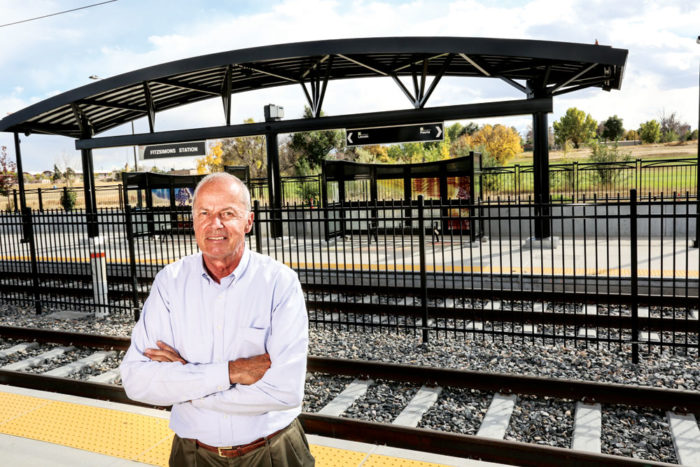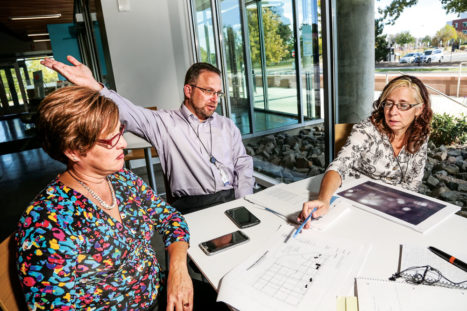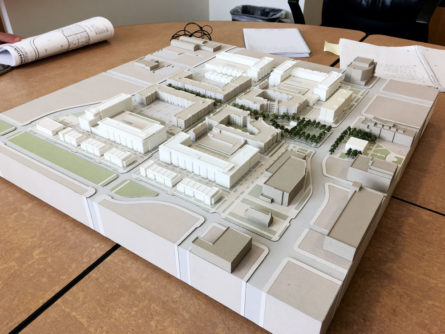
Long-time real estate professional John Shaw manages the Fitzsimons Redevelopment Authority real estate portfolio.
Three mass transit projects are bringing new mobility options to Stapleton and surrounding neighborhoods:
—Commuter rail service on the A Line began in April with direct service to Stapleton at the Central Park Station.
—Light rail service on the R Line through Aurora and along the perimeter of the Anschutz Medical Campus begins at year’s end.
—Planning continues for the development of bus rapid transit (BRT) in the Colfax corridor from downtown out to Fitzsimons in Aurora.
With these transit systems come expectations that dense, mixed-use urban development will follow. Zoning and planning efforts in Denver and Aurora are intended to stimulate housing and commercial projects near high-frequency stations. With the Denver region continuing to grow rapidly, what kind of transit-oriented development (TOD) might we see in these three areas?
Starting with the Fitzsimons Parkway Station this month, the Front Porch will offer a status report on the three TOD opportunities bracketing Stapleton.
Fitzsimons Parkway Station Plan
As robust as growth has been in Stapleton, redevelopment of the former Fitzsimons Army Base has been just as spectacular. And, more development (housing and a hotel) is anticipated beginning next spring.
Most of the north half of the square-mile site remains available for development. That is the half owned by the Fitzsimons Redevelopment Authority (FRA) north of Montview Blvd. Based on plans developed soon after the base closed in 1999, the north half of the campus was envisioned as a bioscience park with Forest City serving as the master developer. Those plans failed to materialize despite Forest City’s multimillion-dollar investment in infrastructure and environmental remediation.
FRA’s current real estate consultant, John Shaw, says the bioscience park concept has become outdated because “Big Pharma” no longer builds such parks, preferring to invest directly in existing research centers focusing on specific products. The FRA now estimates a bioscience build-out demand of 20–30 acres. The question became what to do with the remaining land (150 acres).
Also, the new R Line route was changed from running through the campus to a perimeter run along Fitzsimons Parkway.
These changes led the FRA and the city to collaborate on a “station area plan” that was adopted by the Aurora City Council in September. Key features of the new plan are shown at right.
The plan also allows the University of Colorado to purchase about 26 acres of FRA land north of its Wellness Center as a land-banking strategy.
As with the previous plan, the layout dooms the Fitzsimons Golf Course, currently operated by the City of Aurora on a year-to-year lease. The golf course will remain open in 2017, but beyond that there are no guarantees.

Aurora staff planners Heather Lamboy, Chad Argentar and Mindy Parnes explain how development of the FRA land is expected to be phased.
Shaw said the FRA will break ground next spring on the first phase of the residential expansion and on a five-story hotel fronting Montview just east of Ursula.
The immediate challenge now is to connect the Fitzsimons Parkway Station to the existing campus a half-mile to the south. Using a federal grant, the city will construct a multiuse path along Fitzsimons Parkway and Ursula Street. Light rail patrons will cross Fitzsimons Parkway using a HAWK signal system (pedestrian-activated flashing light system with prominent cross-walk markings). For its part, the university will begin a shuttle bus system, also using the Ursula St. alignment and wending its way along Montview and south to 17th Ave.
Aurora planning staff said such mobility infrastructure is critical now that development of the FRA land is proceeding from south to north, toward the light rail station. Chad Argentar, economic and business development supervisor, expects the city to eventually approve tax increment financing (TIF) that would help ensure that critical connections, such as the proposed Scranton Parkway, are timed to new development. One final step remains, says Mindy Parnes, planning supervisor, as the FRA seeks full entitlement of its planned development: city approval of design guidelines to ensure an urban look and feel.
Shaw says next spring the FRA will be submitting a proposal for a build-to-suit structure to house a “biotherapeutics” firm interested in locating at Fitzsimons. He also eagerly awaits the extension of MLK Blvd. from Stapleton to Fitzsimons Parkway, which he thinks will further stimulate development.

Features of the Fitzsimons station area plan include:
- Establishing an urban street grid highlighted by a new Scranton Pkwy. extending south from the Fitzsimons Pkwy. station to the heart of the campus. New east-west streets would be located in the 23rd and 25th Ave. alignments.
- Addition of 850 dwelling units encircling the town green located at Montview and Ursula St.
- Reserving a 40-foot wide linear park along the Peoria and Fitzsimons Pkwy. street frontages. The park will include a wide multi-use path envisioned as ultimately encircling the entire Fitzsimons campus.
- Within the street grid, more flexibility regarding uses block by block. The zoning will preclude retail uses exceeding 20,000sf, meaning there will be no big box development on FRA land.



It was idiotic to move the station a half mile north of the campus, in between open space and a golf course – literally the middle of nowhere – when thousand of jobs and customers could’ve been served.